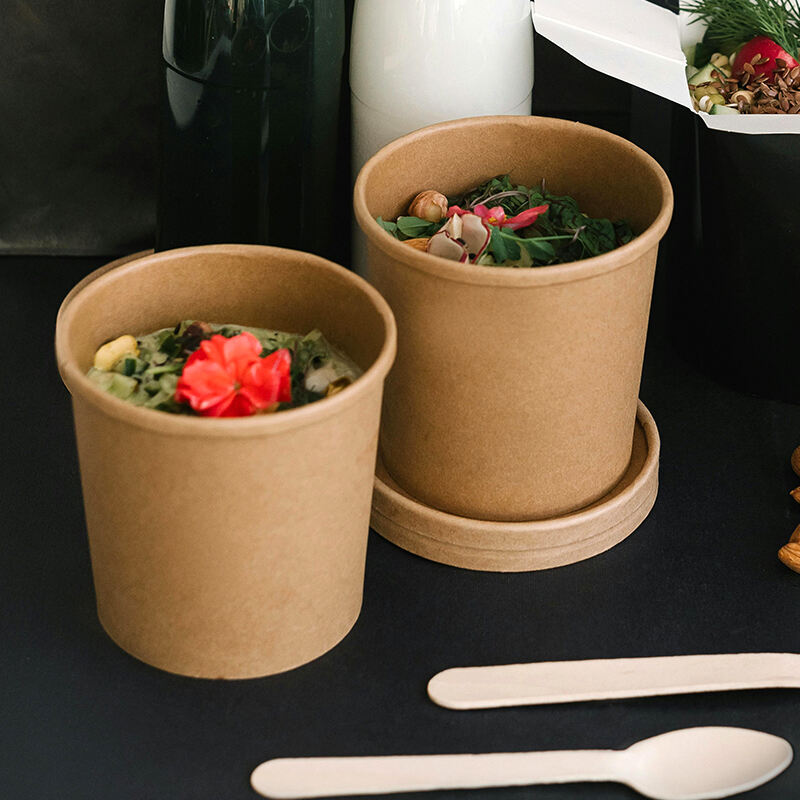ההעברה הגוברת לפתרונות אריזה ידידותיות לסביבה בתחום המזון
במרחב המתפתח של אמצעי האחסון לשירותי מזון, נייר קערות מרק הפכו לאפשרות פופולרית יותר ויותר בקרב מסעדות, כנסיות ואספקת שירותי מזון. ככל שמודעות הסביבה גדלה ותקנות על פלסטיק חד-שימוש הופכות מחמירות יותר, חברות רבות reassess את בחירות האריזה שלהן. ההשוואה בין צלחות סופ לנייר לבין חלופות פלסטיק או קצף חושפת הבדלים משמעותיים בהשפעה סביבתית, תפקודיות ויעילות עלות.
השינוי בתעשיית שירותי המזון נבע הן מדרישות הצרכנים והן מהצורך הסביבתי. עם מיליוני מיכלי המאכלים שמיוצרים מדי יום ברחבי העולם, לבחירת החומרים יש השלכות רחבות על בריאות כדור הארץ ועל חוויית הארוחה של הצרכנים. הבנת ההבדלים האלה עוזרת לעסקים לקבל החלטות מושכלות המתאימות הן לצרכים אופרטיביים והן למטרות של קיימנות.
השפעה סביבתית ותכונות תקינות
התפרקות ביולוגית וצמצום פסולת
כוסות נייר לスープ מציגות יתרון משמעותי במונחים של התפרקות ביולוגית. בניגוד לחבריהם מפלסטיק ומשרף, שיכולים לקחת מאות שנים להתפרק, מיכלים מנייר מתפרקים בדרך כלל תוך 2–6 חודשים בתנאים מתאימים. התפירה המהירה הזו מקטינה משמעותית את העומס על מכרות זבל ומצמצמת את ההשפעה הסביבתית ארוכת הטווח.
תהליך הייצור של קערות נייר לスープ נוטה להיות עם אפקט פחמן נמוך יותר בהשוואה לחלופות מפלסטיק או קצף. קערות נייר רבות מיוצרות באמצעות חומרים מחזוריים ואמצעי ייעור בר-קיימא, מה שמגביר עוד יותר את תעודת הקיימות הסביבתית שלהן.
שמירת משאבים והשפעת ייצור
ייצור קערות נייר לスープ דורש בדרך כלל פחות אנרגיה ופחות משאבים לא מתновזרים בהשוואה לאפשרויות מפלסטיק או מקצף. בעוד שריכוזים מפלסטיק הם מוצרים מבוססי נפט, ניתן לייצר קערות נייר באמצעות בוץ עץ מתחדש וחומרים מחזוריים. להבדל זה במקורות החומרים הגולמיים השלכות משמעותיות על שימור המשאבים ועל קיימות.
יתרה מכך, מתקני ייצור מודרניים של קערות ניירчастו מממשים מערכות לולאה סגורה שמפחיתות עד המינימום את צריכה המים ואת מחזור חומרי הייצור, ובכך מפחיתות עוד יותר את ההשפעה הסביבתית.
היבטים של ביצועים ופונקציונליות
שמירה על חום ובידוד
כוסות נייר לスープ עשו צעדים משמעותיים ביכולת שמירה על חום. כוסות נייר מודרניות מציגות לעתים קרובות בנייה רב-שכבתית שמאפשרת תכונות בידוד מצוינות, שומרות על מזון חם בטמפרטורה הרצויה תוך כדי שהן נוחות להחזק. בעוד שמכלי פוליאסטר ידועים מסורתית בשל תכונות הבידוד שלהם, עיצובים מתקדמים של כוסות נייר מציעים כיום ביצועים דומים.
התכונות התרמיות של כוסות נייר לスープ ניתן לשפר באמצעות ציפויים מיוחדים וטכניקות בנייה, מה שמאפשר להן לשמור על טמפרטורת המזון בצורה יעילה מבלי לפגוע בטבע החriendly-האקולוגי שלהן.
עמידות ועמידות למצבור
כוסות נייר יומיות כוללות טכנולוגיות ציפוי מתקדמות שמאפשרות התנגדות דליפה טובה ויציבות מבנית. שיפורים אלו פותרים דאגות היסטוריות בנוגע ליכולת של מיכלי נייר להכיל נוזלים חמים ולמנוע דליפה. הרבה מכוסות נייר מצויות כעת עם מחסומים בנייר מאושר למזון, שממשיכות לשמור על המבנה שלהן גם כאשר הן ממולאות בסופים או רטבים חמים לאורך זמן.
בעוד שמיכלים מפלסטיק ומפולי סטירין מוערכים כבר זמן רב בשל אמינותם, כוסות נייר מודרניות מראות ביצועים דומים ביישומים בשטח, ועתים קרובות עולות על הציפיות של הלקוחות בנוגע לעמידות.
שקולים כלכליים וניתוח שוק
מחיר רכישה ראשוני וכמויות
מבנה העלות של קערות נייר לスープ השתנה בצורה משמעותית עם שיפור טכנולוגיות הייצור ועליית הביקוש. בעוד עלות היחידה של קערות נייר עשויה להיות גבוהה יותר במעט מאלטרנטיבות פלסטיק או קצף בסיסיות, הפער במחיר הצטמצם במידה ניכרת בשנים האחרונות. תמחור כמותי ותחרות מוגברת בשוק הפכו את קערות הנייר לסלט סuppe למתחרה על 비ות כלכלית.
בעת שוקלים את עלות הפעלה כוללת, מגוון עסקים מגלים כי העדיפות הנוספת עבור קערות נייר מפוצה על ידי העדפת הלקוחות והטבות אפשריות בהיבטי תאימות רגולטורית.
יתרונות כלכליים לטווח ארוך
השקעה בקערות נייר יכולה להניב יתרונות כלכליים ארוכי טווח. ככל שהתקנות הסביבתיות הופכות מחמירות יותר ואיסורי פלסטיק חד-שימוש מתרחבים, עסקים המשתמשים בחילופים מנייר מצויינים במיקום טוב יותר כדי להימנע מעמלות תאימות עתידיות וקנסות אפשריות. יתר על כן, הדמות החיובית של המותג המשויכת לעריכה ברת קיימא יכולה להוביל לעלייה באמונה של הלקוחות ולשיפוץ נתח השוק.
רבות מהמוסדות מדווחים כי המעבר לקערות נייר לスープ השפיע על שולי הרווח שלהם באופן חיובי, הודות להגברת שביעות רצון הלקוחות ולחיזוק תדמיתם בתחום האחריות הסביבתית.
שאלות נפוצות
האם קערות נייר לスープ אכן טובות יותר לסביבה?
באופן כללי, לקערות נייר לスープ יש השפעה סביבתית מינורית בהשוואה לחלופות פלסטיק או קצף. הן מתפרקות במהירות רבה יותר, לעתים קרובות מיוצרות מחומרים מתחדשים, ודורשות פחות אנרגיה לייצור. כשנרכשות מייצרנים אמינים המשתמשים בשיטות ייצור עמידות, קערות נייר מהוות בחירה ידידותית יותר לסביבה.
כמה טובות קערות נייר לスープ בניהן עם נוזלים חמים?
קערות נייר מודרניות מעוצבות באמצעות שכבות מרובות וציפויים מיוחדים שמבטיחים שמירה מעולה על החום ואתמאות המבנית. הן יכולות להכיל בביטחון סופות ונוזלים חמים בטמפרטורת השרת מבלי לפגוע במבנה שלהן או לגרום לאכזבה למשתמשים.
מה גורם לקערות נייר לスープ להיות כד economical לאורך זמן?
בעוד קערות נייר לスープ עלולות להיות יקרות יותר במעט לאחת, הן מציעות ערך ארוך טווח הודות לעמידה בדרישות רגולטוריות, שיפור דימוי המותג והעדפת הלקוחות לאפשרויות עמידות. ככל שעליית הקנה מתרחבת ושיטות הייצור משתכללות, הפער במחיר מצטמצם, מה שהופך אותן לאפשרות מושכת יותר ויותר לעסקים בתחום שירותי המזון.
